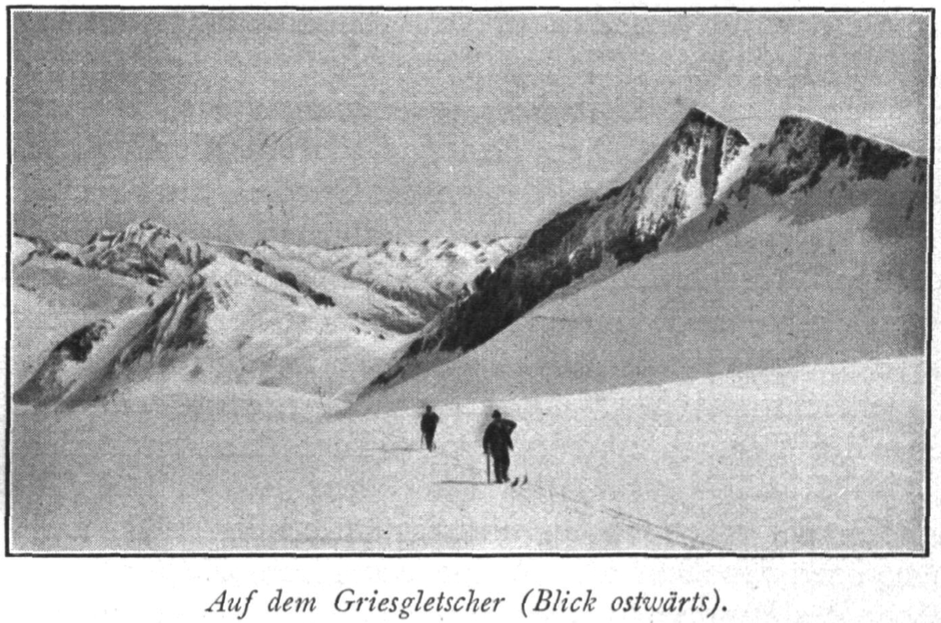Skifahrt auf das Blindenhorn.
von Henry Hoek
Das Leben ist die Fülle, nicht die Zeit.« Schnitzler.
In traulichen Stunden sanften Abenddämmerscheines schleicht gerne auf sammetnen Sohlen Erinnerung ins Zimmer. Sie erzählt flüsternd von mancher schönen Winterfahrt, von mancher frohen Skitour in Hochgebirgsherrlichkeit. Dann kommt manche Beobachtung, jede Erfahrung erst zur richtigen Geltung; des Augenblicks Begeisterungsrausch verflog und kühler kritisieren kann die Vernunft.
Auf eine ganze Reihe alpiner Skifahrten darf ich zurückblicken. Es waren gewiß die Touren, die ich zu meinen eindrucksreichsten und genußvollsten zähle. Betrachte ich sie aber vom sportlichen Standpunkte aus — ich muß gestehen, wer den Sport des Skilaufs sucht, der findet mehr Genuß im Mittelgebirge und in den Voralpen. Im Hochgebirge, da war mir der Ski fast immer nur Mittel zum Zweck. Und er wird auch wohl beinahe ausnahmslos nur ein Hilfsmittel des Hochtouristen bleiben, ihm der Berge Winterschönheit zu erschließen — als Sportgerät kann er kaum jemals im Mittelpunkte des Interesses stehen.
So war es bei allen alpinen Skifahrten, so vieler ich gedenken mag. So war es bei der Tour zu den eisumflossenen Klippen der Grands Mulets, einem Gelände, wie es für Schneeschuhe kaum ungeeigneter gedacht werden kann, so war's bei der Durchquerung des Berner Oberlandes, der gepriesenen und gelobten »Hohen Straße.
Nur eine Ausnahme blieb mir in angenehmer Erinnerung als idealste Verbindung einer prächtigen Hochgebirgswanderung, verbunden mit dem ungetrübten Genüsse sportlich schönen Skilaufs in einer wie für Schneeschuhe eigens geschaffenen Gegend. Das war unsere Fahrt von Airolo auf das Blindenhorn in den ersten Tagen des April 1903. Von der will ich hier erzählen, was mir an Erlebtem und Empfundenem einfällt. »An Erlebtem und Empfundenem? Ressentiments? Wir danken.« Oh ja, ich weiß! Es ist viel gespottet, viel gehöhnt worden über die Gefühle und Empfindungen, die am Schreibtisch »konstruiert seien«. Zum Teil mit Recht, zum Teil mit Unrecht, dünkt mir. Man darf nicht alles in einen Topf tun. Wohl: Auch ich kenne leider genug Tourenberichte voll unmöglicher, weil unwahrer Gefühlsergüsse. Fort damit!
Doch ist deswegen alles verwerflich, was das Gebiet des später — des Nachempfundenen berührt? Gewiß — was da in schönen Worten gekleidet, den Gang in die Welt hinaus antritt, das kam momentan nicht so zum Bewußtsein, konnte inmitten körperlicher Anstrengung, inmitten sich drängender Eindrücke, anstürmender Bilder nicht bewußt werden, wird es nie werden können.
Ist es aber wirklich so unstatthaft, das Bild des Genossenen später in stiller Nacht am Schreibtische zu beschwören, zu betrachten und sein Empfinden daran zu beleben und dann zu analysieren — ist das wirklich ein ästhetisches Verbrechen, dann ist alles unerlaubt und verwerflich, was über Xenophontis trockenen Chronistenstil hinausgeht; dann aber ist auch dein Wandern, dein Schreiben umsonst, ist toter Buchstabe, günstigsten Falls Wust zum Nachschlagen.




